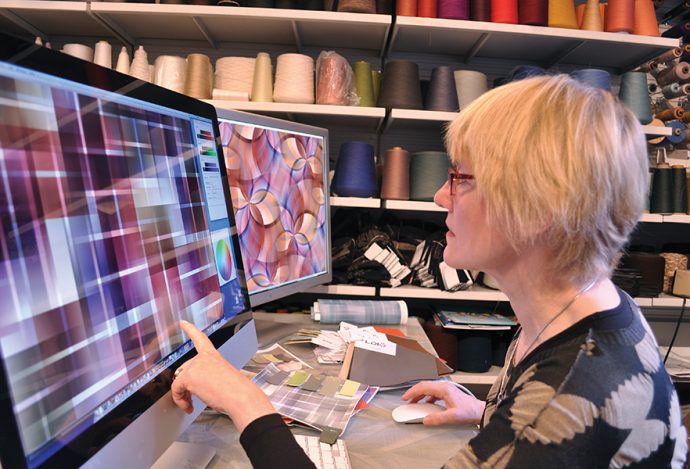A walk around Jhane Barnes’ bright and airy design studio, located inside a spacious Waccabuc home just a five-minute drive from her actual residence in the hamlet, reveals a vast array of samples from the award-winning clothing and product lines she’s created over the past four decades.
They range from Barnes’ renowned luxury menswear that launched her career back in 1976 to her sophisticated carpeting, flooring, textile, furniture and eyewear collections.
What makes Barnes stand out in the design world is her ability to conceive beautifully complex patterns on a computer using her own customized software. The results are alluring blends of colors, shapes and textures that are based on mathematics, specifically algorithms (sets of rules or instructions to perform a task) which she alters and enhances to create her distinctive style.

Growing up outside of Baltimore, Barnes was always drawn to math and science and even dreamed of becoming an astrophysicist one day. However, her high school trigonometry teacher gave her a D and tried to dissuade her from going in that direction. “He told me I would only be an average scientist, but my personality was definitely not average,” she says.
As it turns out, the person who saw immense talent in Barnes was her experimental clothing design course instructor, who took her on a senior class trip to Europe and introduced Barnes to the fashion scene at such haute couture houses as Gucci, Pucci and Yves Saint Laurent. “My teacher went to my parents and told them that I had to go to design school,” Barnes recalls. “Not only that, she said it had to be in Manhattan, because it’s the most important city for fashion.”
Barnes was accepted into the Fashion Institute of Technology and her first big break came at the end of her senior year in 1976. That’s when she was included among the top students chosen to present their clothing designs at a fashion show attended by leading industry representatives.
After the show, Barnes gave her model the clothes she had created and he wore them out to a restaurant that night. “A retail executive spotted them and said, ‘Those are the best-fitting pants I’ve ever seen,’” she recalls. “He told my model that I should come to his office the next morning and ended up ordering 1,000 pairs. I had to borrow $5,000 from my biology professor to fill the order.”
Barnes’ distinctive line of men’s clothing became known for its unusual details and silhouettes, from her pants with no back pockets to her sport coat blousons and pleated yoke jackets. Among those spotted wearing her earliest designs were John Lennon and Paul Simon, and they were also favorites of Elton John, Bruce Springsteen, Jack Nicholson and even President Bill Clinton.
In addition, Barnes designed the basketball uniforms for the NBA’s Orlando Magic, and her clothing was sold at such large retail chains as Saks, Neiman Marcus, Bloomingdale’s and Nordstrom.
Her trigonometry teacher would be surprised at how integral math, science and technology have become to Barnes’ work. “I was never a very good artist and drawing didn’t come easy to me. However, I was an early adapter of the computer,” she says.
Barnes started weaving her own textiles and got an Atari game computer to operate her looms in 1984. “That was my first computer and I learned how to expand the design of my textiles by doing longer repeats and larger patterns, because I didn’t have to hold it all in my head,” she says.
Barnes soon switched to Mac computers, and in 1992 hired William Jones, a mathematician (who recently passed away), and Dana Cartwright, a physicist and software developer, both from Syracuse University, to help her with her designs. “In the beginning, they didn’t know much about textiles and I didn’t know much about math, so over the years we had to teach each other our vocations,” she says.
Together, they worked out a system in which Barnes would develop new concepts — whether based on fractal geometry inspired by mathematician Benoit Mandelbrot or DNA codes, starbursts and galaxy clusters — and Cartwright and Jones would write the new codes to generate the patterns for her to adapt on the computer.
Barnes explains she never follows trends but rather “creates from within to try to control all the processes of the final product. My inspiration is all the computer tools I’ve built over the years. I’ve built so many with my mathematicians, and they’re all ideas that I dream about or wake up with. I’ll never run out of ways of combining them because we’re always writing new ones.”
In talking about how she transferred her menswear concepts over to contract (business to business) interior design, Barnes says, “What made menswear salable for me was that, from a distance, I never made guys look like they stood out in a crowd. But the nearer you got to them, the more interesting their clothing became.” She adds: “Customers would keep my clothes in their closet for many years, because there was always something new to discover about them.”
Barnes says the same concept also works great with the interior products she designs. As an example, she points out that commercial carpets have to be on the floor for seven to 15 years. “You have to be able to walk into a building or your office and not say, ‘Oh no, not that carpet again.’ It has to be something that’s pleasing and also makes you want to look at it and inspire you,” she says.
Working with the company Tandus Centiva (formerly Tandus Flooring) for more than 20 years, Barnes has designed carpets and flooring for some of the world’s largest corporations, universities and health care companies, including PepsiCo (in its former Somers headquarters), Gensler, Kaiser Permanente and Bank of America, as well as Mercedes-Benz, Rolls-Royce, Stanford University and Northwestern University Pritzker School of Law.
Barnes says that one of her biggest inspirations lately came from observing the broad mixture of angles and curves in the large public spaces inside the new buildings she’s been designing carpets for across the country. “Designers don’t want very linear carpeting, because it may not look good, especially when it hits a curve,” she says. “Our newest patterns don’t use any horizontal, vertical or right angles. Instead, they’re all acute and obtuse so you can turn them any which way in a space and not fight with the parameters of the building.”
Through the years Barnes has been in business, she’s also created innovative lines of colorful, computer-generated textiles and upholstery designs for industry leaders such as Knoll, Anzea and LDI as well as trend-setting furniture for Bernhardt (including her elegant “Martini Table”), resin panels for Lumicor and signage for a company called Takeform.
If that’s not enough, she is designing glasses for Kenmark Eyewear. (CEO Don Howard was a big fan of her clothing.) “One of our newest frames is made with sunglass material, making the rims reflective. Another is a metal frame inside a clear plastic frame, so you get the look of metal with the comfortable fit of the plastic,” she says.
In 2013, Barnes decided to discontinue manufacturing men’s clothing (except for her successful line of socks that is still sold online). However, she remains totally focused on the industrial design side of her business, which generates more than $40 million in revenue per year for her client companies.
As far as the future and her next product line, Barnes says, “My whole career, I’ve never had a plan. The only thing that’s always out there is that I love creating and I love working, so I’ll never retire.” She adds, “If someone asks me to design something, I’m ready. I can sit and wait for the next gig to come. And it usually does!”
For more, visit jhanebarnes.com.




